Building industry-wide research and innovation capability by training the future grains knowledge workforce is one of the core objectives of the Victorian Grains Innovation Partnership – an eight-year, $88 million co-investment by GRDC and Agriculture Victoria.
Located at a world-leading research precinct at Horsham, in the heart of the Victorian grainbelt, six PhD research fellowship recipients are studying priority industry issues.
The students are part of the Centre for Agricultural Innovation, a joint initiative between Agriculture Victoria and the University of Melbourne.
Pulse root architecture
Roots are a critical, yet under-studied, component of pulse productivity and Spencer Fan is developing assays to assess variability in pulse root traits. Significant variation has been found and he is now keen to investigate root plasticity – the ability of the root to change its growth pattern in a range of soils in search of nutrients or water.
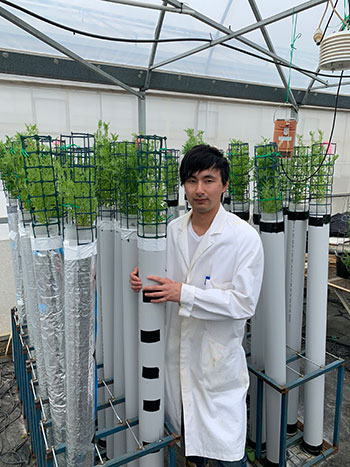 Spencer Fan examining root system architecture, including rooting depth of pulses in deep cores. Photo: DEDJTR
Spencer Fan examining root system architecture, including rooting depth of pulses in deep cores. Photo: DEDJTR
The results of his PhD will give insights into the types of root architecture that are most-suited to Victoria’s various cropping regions.
Mr Fan’s interest in plant science was sparked by his undergraduate degree in science at the University of Melbourne.
“Towards the end of my degree, I was fortunate to undertake an internship with the Agriculture Victoria pulse breeding group at Horsham,” he says.
“The positive experience from the internship led me to complete a master of agricultural science, completing a major research project with Agriculture Victoria that investigated how changes in above ground field pea architecture influences yield.”
Mr Fan was introduced to his PhD supervisors, Professor Roger Armstrong and Dr Garry Rosewarne, during this research project, which ultimately led him to pursue a PhD focusing on root architecture in pulses.
Mungbeans for south-eastern Australia
Sachesh Silwal brings years of experience, working on plant adaptation, to his study of mungbean adaptation for south-eastern Australia.
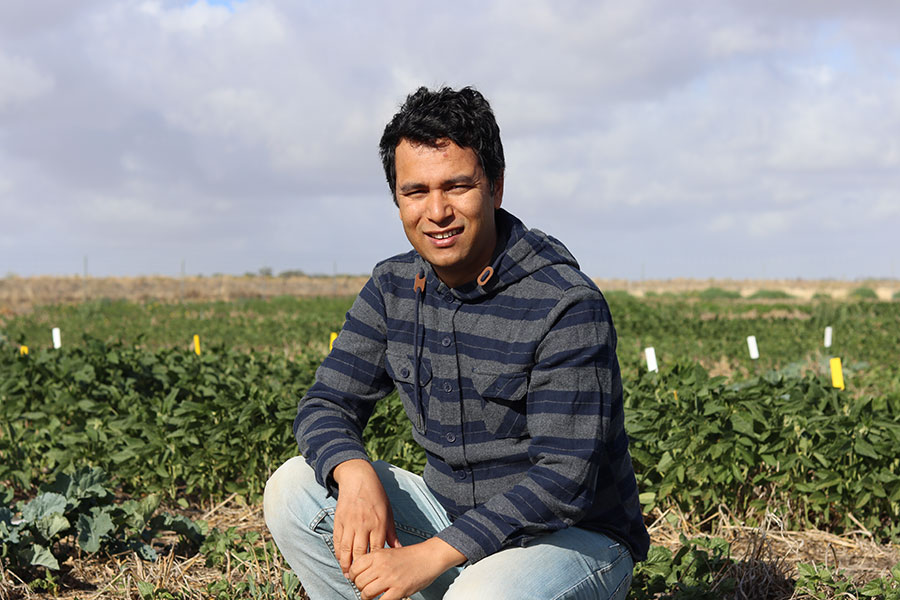 Sachesh Silwal is focusing on mungbean adaptation in southern Australia for his PhD study. Photo: DEDJTR
Sachesh Silwal is focusing on mungbean adaptation in southern Australia for his PhD study. Photo: DEDJTR
“I was born in Nepal and completed my degree in plant breeding at Tribhuvan University, Nepal, in 2005, before moving to Australia in 2013,” he says. “I completed a Master of Applied Science (Research) at Central Queensland University in 2017.
“Over the past 10 years or more I worked in plant breeding, agronomy and plant physiology research with various crops under different agro-ecologies, including dryland, high mountain, temperate and tropical, within commercial and subsistence farming.”
Mr Silwal is now applying his experience to evaluating the agronomic suitability of mungbeans to southern Australia by exploring crop phenology, temperature responses, water and nitrogen dynamics, under the guidance of supervisors Dr James Nuttall, Dr Sally Norton, Audrey Delahunty and Associate Professor Joe Panozzo.
On-farm storage to optimise lentil quality
Bhawana Bhattarai is investigating the effects of storage conditions on lentil quality initially using laboratory experiments.
Using data collected to build biophysical models that explain changes in lentil quality during storage, Ms Bhattarai is then transferring this knowledge to larger cone-type storage facilities used by growers. This study is important to help growers monitor and optimise on-farm storage conditions to maintain grain quality and maximise returns.
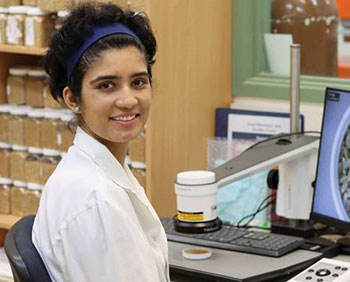 Bhawana Bhattarai collecting digital images of stored lentils to monitor colour changes. Photo: DEDJTR
Bhawana Bhattarai collecting digital images of stored lentils to monitor colour changes. Photo: DEDJTR
Ms Bhattarai completed a Bachelor of Science in Agriculture at Tribhuvan University, followed by a Master of Biotechnology and Bioinformatics in 2019 at La Trobe University.
“I believe that agricultural systems can feed the world, which is becoming more populated, but they need to be productive, efficient and profitable,” she says. “Grain storage on-farm plays an important role in the quality and price of the grain, and I’m keen to investigate best practices that growers can implement.”
Ms Bhattarai’s PhD study is being supervised by Associate Professor Glenn Fitzgerald, Dr Cassandra Walker, Dr James Nuttall, Dr Kate Howell and Ashley Wallace.
Sensor technologies to determine pulse quality
Different abiotic and biotic stresses – including heat, drought and disease – impact grain development and quality in pulses.
Danielle Tang is investigating how sensor technologies can be used to assess lentil and faba bean crops before harvest and the impact of various stress factors on grain quality.
“This will be a significant gain for growers as it will enable segregation of grain during harvest with the aim of capturing premiums to achieve grade-one pulses,” she says.
For example, a small, badly diseased section of a paddock might lead to a downgrade in quality if the paddock was harvested as a whole. But by segregating the diseased area, the rest of the paddock could attract a price premium.
Ms Tang completed her Bachelor of Agriculture at the University of Melbourne in 2019. “I’m interested in seeing how agriculture can be made a more-sustainable industry with the use of advanced sensor technologies,” she says.
“In my honours project, I explored machine learning techniques and how, using sensor technologies, these can be applied to develop models to predict wine quality. I will now l apply these skills in pulses in my PhD project.”
Ms Tang’s study is being supervised by Associate Professor Glenn Fitzgerald, Dr Cassandra Walker, Dr Dorin Gupta, Dr James Nuttall and Audrey Delahunty.
Soil constraints
Life spent on Keshia Savage’s grandfather’s farm in the western district of Victoria gave her a passion for agriculture, leading to study at Longerenong Agricultural College and then a technical role in pulse agronomy at Agriculture Victoria.
“This research experience encouraged me to obtain a Bachelor of Agricultural Science from La Trobe University. Pursuing a PhD in this field is not only a logical step in my education but a chance for me to contribute to an industry supporting local growers and our global food supply,” Ms Savage says.
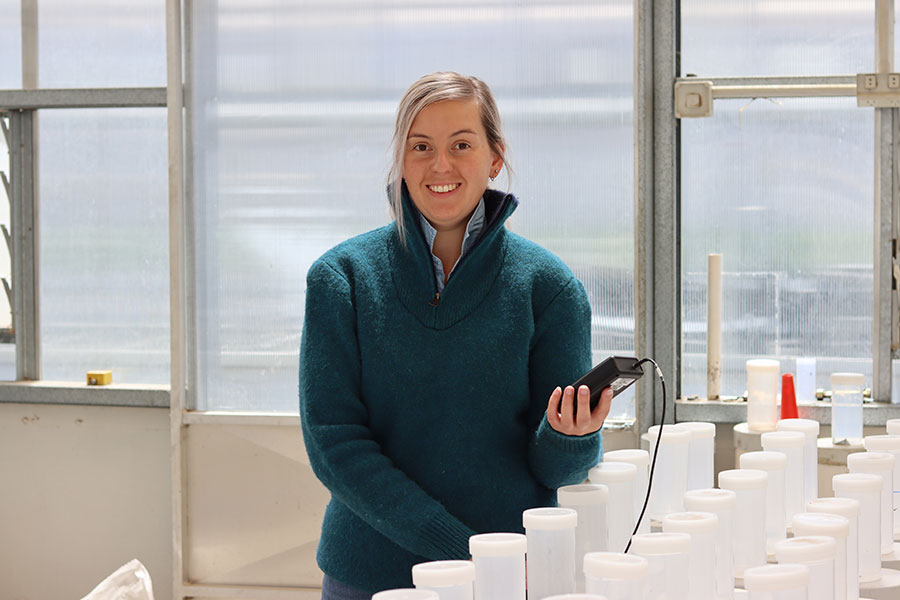 Keshia Savage measuring leaf transpiration on different wheat germplasm. Photo: DEDJTR
Keshia Savage measuring leaf transpiration on different wheat germplasm. Photo: DEDJTR
“For my PhD, I’m looking to understand the mechanisms by which multiple soil constraints affect annual dryland crops to help identify and develop more-effective management strategies that improve crop production.”
Soils can vary enormously within a paddock and it’s important to understand how various constraints interact and what practices can help overcome those.
Ms Savage’s PhD study is being supervised by Professor Roger Armstrong and Dr Clayton Butterly.
Her research project involves controlled-environment and field research, and will use a range of soil and crop sensing technologies to examine the relationship between soil physico-chemical properties and the response of grain crops to different management interventions on a three-dimensional spatial scale.
Novel soil management to boost rainfall use
Water deficits are the principal limitation to grains productivity and profitability in Australian temperate cropping systems.
Amit Adhikari is developing and assessing the potential of new management strategies to improve the capture and utilisation of rainfall by grain crops in future climates.
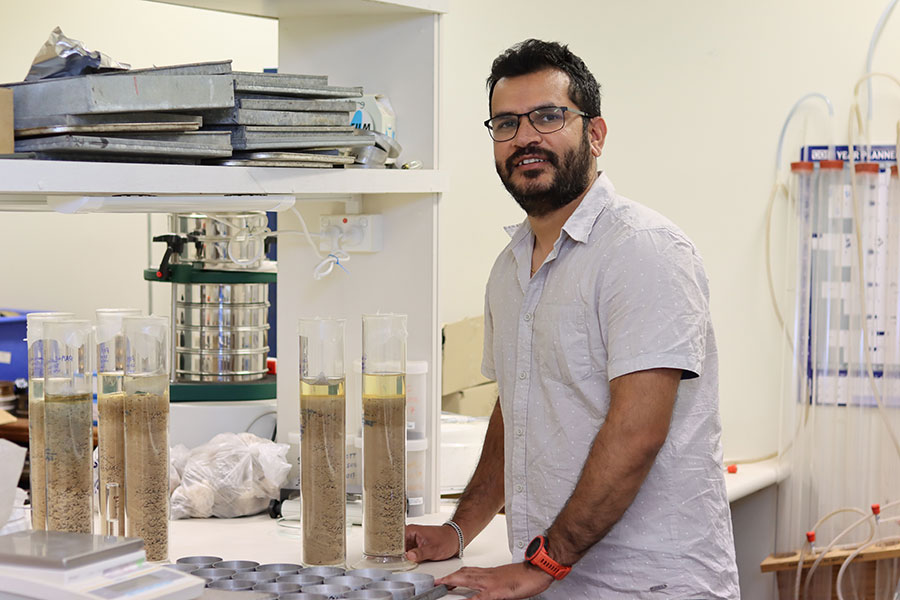 Amit Adhikari examining the effect of different soil polymers on water infiltration. Photo: DEDJTR
Amit Adhikari examining the effect of different soil polymers on water infiltration. Photo: DEDJTR
“Rainfall patterns are variable and changing, and this gives us new opportunities for water conservation options. Using a specially constructed rainfall simulator in the field, my experiments aim to help develop practices that increase crop water use with novel soil engineering techniques such as polymers and stubble management,” Mr Adhikari says.
Mr Adhikari completed his bachelor and Master of Science in Agriculture at Tribhuvan University in Nepal. He has more than five years’ experience working in crop and soil science.
He moved to Australia in 2017 and worked in agribusiness for two years before commencing his PhD in October 2020. His studies are being supervised by Professor Roger Armstrong, Dr Garry O’Leary and Dr Clayton Butterly.
More information: Dr Jennifer Sexton, 0438 981 294, jennifer.sexton@agriculture.vic.gov.au

























































